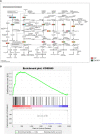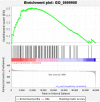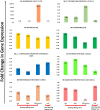Comparative transcriptomics in alternate bearing cultivar Dashehari reveals the genetic model of flowering in mango
- PMID: 36704344
- PMCID: PMC9871253
- DOI: 10.3389/fgene.2022.1061168
Comparative transcriptomics in alternate bearing cultivar Dashehari reveals the genetic model of flowering in mango
Abstract
Flowering is a complex developmental process, with physiological and morphological phases influenced by a variety of external and internal factors. Interestingly, many mango cultivars tend to bear fruit biennially because of irregular flowering, and this has a negative impact on mango flowering and the subsequent yield, resulting in significant economic losses. In this article, transcriptome analysis was carried out on four tissues of mango cv. Dashehari (bearing tree leaf, shoot apex, inflorescence, and non-bearing tree leaf). De novo transcriptome assembly of RNA-seq reads of Dashehari using the Trinity pipeline generated 67,915 transcripts, with 25,776 genes identified. 85 flowering genes, represented by 179 transcripts, were differentially expressed in bearing vs. non-bearing leaf tissues. Gene set enrichment analysis of flowering genes identified significant upregulation of flowering related genes in inflorescence tissues compared to bearing leaf tissues. The flowering genes FT, CO, GI, ELF 4, FLD, FCA, AP1, LHY, and SCO1 were upregulated in the bearing leaf tissues. Pathway analysis of DEGs showed significant upregulation of phenylpropanoid and sucrose and starch pathways in non-bearing leaf tissue compared with bearing leaf tissue. The comparative transcriptome analysis performed in this study significantly increases the understanding of the molecular mechanisms driving the flowering process as well as alternative bearing in mango.
Keywords: Dashehari mango; RNA-seq; alternate bearing; floral development; flowering genes.
Copyright © 2023 Kaur, Sidhu, Mittal, Yadav, Mittal, Singla, Singh and Chhuneja.
Conflict of interest statement
The authors declare that the research was conducted in the absence of any commercial or financial relationships that could be construed as a potential conflict of interest.
Figures









Similar articles
-
Comparative RNA sequencing based transcriptome profiling of regular bearing and alternate bearing mango (Mangifera indica L.) varieties reveals novel insights into the regulatory mechanisms underlying alternate bearing.Biotechnol Lett. 2020 Jun;42(6):1035-1050. doi: 10.1007/s10529-020-02863-8. Epub 2020 Mar 19. Biotechnol Lett. 2020. PMID: 32193655
-
Rootstock-mediated carbohydrate metabolism, nutrient contents, and physiological modifications in regular and alternate mango (Mangifera indica L.) scion varieties.PLoS One. 2023 May 3;18(5):e0284910. doi: 10.1371/journal.pone.0284910. eCollection 2023. PLoS One. 2023. PMID: 37134101 Free PMC article.
-
Studies on the expression patterns of the circadian rhythm regulated genes in mango.Physiol Mol Biol Plants. 2021 Sep;27(9):2009-2025. doi: 10.1007/s12298-021-01053-8. Epub 2021 Sep 8. Physiol Mol Biol Plants. 2021. PMID: 34629775 Free PMC article.
-
Mechanisms and function of flower and inflorescence reversion.J Exp Bot. 2005 Oct;56(420):2587-99. doi: 10.1093/jxb/eri254. Epub 2005 Aug 30. J Exp Bot. 2005. PMID: 16131510 Review.
-
Advances in Physiological, Transcriptomic, Proteomic, Metabolomic, and Molecular Genetic Approaches for Enhancing Mango Fruit Quality.J Agric Food Chem. 2023 Jan 11;71(1):20-34. doi: 10.1021/acs.jafc.2c05958. Epub 2022 Dec 27. J Agric Food Chem. 2023. PMID: 36573879 Review.
Cited by
-
Interacting MeZFP29 and MebZIPW regulates MeNRT2.2 from cassava responding to nitrate signaling.Plant Cell Rep. 2025 Mar 4;44(3):69. doi: 10.1007/s00299-025-03455-4. Plant Cell Rep. 2025. PMID: 40032691
-
Molecular Insights into Abiotic Stresses in Mango.Plants (Basel). 2023 May 9;12(10):1939. doi: 10.3390/plants12101939. Plants (Basel). 2023. PMID: 37653856 Free PMC article. Review.
References
-
- Aljaser J. A., Anderson N. O., Noyszewski A. (2021). Discovery of UPSTREAM OF FLOWERING LOCUS C (UFC) and FLOWERING LOCUS C EXPRESSOR (FLX) in Gladiolus ×hybridus, G. dalenii. bioRxiv 2, 1–11. 10.48130/opr-2022-001310.1101/2021.07.02.450944 - DOI
-
- Bajpai A., Khan K., Muthukumar M., Rajan S., Singh N. K. (2018). Molecular analysis of anthocyanin biosynthesis pathway genes and their differential expression in mango peel. Genome 61, 157–166. Available at: www.nrcresearchpress.com . 10.1139/gen-2017-0205 - DOI - PubMed
-
- Chacko E. K. (1986). “Physiology of vegetative and reproduction growth with mango (Mangifera indica L.) trees,” in Proceedings 1st Australian Mango Research Workshop, CSIRO Australia 1984, Melbourne, 54–70.
LinkOut - more resources
Full Text Sources
Miscellaneous

